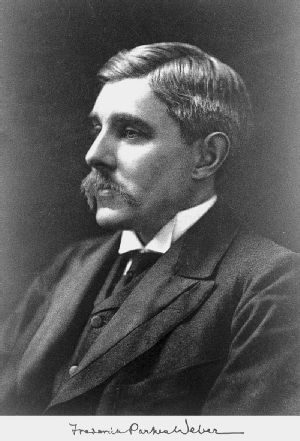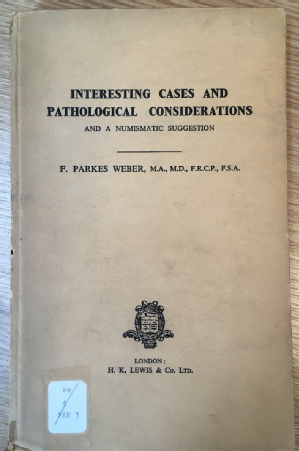All 1 entries tagged Royal Numismatic Society
No other Warwick Blogs use the tag Royal Numismatic Society on entries | View entries tagged Royal Numismatic Society at Technorati | There are no images tagged Royal Numismatic Society on this blog
June 01, 2020
Frederick Parkes Weber and the Bowl of Coins Prize
 |
 |
|
Frederick Parkes Weber,
|
Interesting Cases and Pathological
Considerations.
|
Amongst the papers of the famous dermatologist Frederick Parkes Weber now housed in the department of Coins and Medals in the British Museum is a book rather intriguingly entitled Interesting Cases and Pathological Considerations and a Numismatic Suggestion. While most of the book will not interest the student of coinage, the ‘numismatic suggestion’ appended at the end provides a great insight into Weber’s knowledge of ancient coinage (he was an avid coin collector) and the Royal Numismatic Society’s Parkes Weber Prize, currently awarded to the best essay ‘of not more than 5,000 words on any subject relating to coins, medals, medallions, tokens or paper money’ written by someone under 30.
The numismatic suggestion (photographs of the text available to read here and here) records that originally Parkes Weber proposed to the Royal Numismatic Society (RNS) an annual ‘bowl of coins’ prize. The idea came to him since, as a collector, he had to frequently quickly assess bowls of coins from various dealers across the world. The council found the suggestion impractical, and so instead implemented the prize in its current form. But it appears that Parkes Weber was not happy with the solution, and so published his original letter of 1st October 1953 to the President of the Royal Numismatic Society ‘in the hope that at some future time my suggestion will be carried out by a society of private donor. I believe that a small analogous prize is being offered to postage stamp enthusiasts with considerable success.’
Reading the letter, Parkes Weber originally proposed to the RNS an annual prize of 10 guineas to young collectors for ‘the best written diagnosis (with half an hour) of the contents of a bowl of miscellaneous coins and coin-like objects (twenty pieces in the bowl) under the supervision of a delegate of the Society in question’. He suggests they should all be good or moderately good specimens, as well as one or two imitations. He then goes on to offer detailed advice on what this ‘bowl of coins’ should contain.
Parkes Weber suggested the bowl should contain two or three counters or admission tickets (e.g. the Nürnberg Rechenpfennige, the card counters struck on the accession of Queen Victoria with the Duke of Cumberland on horseback on the reverse). He also suggests the inclusion of Greek and Roman tokens, including the so-called spintriae. These tokens carry sexual imagery on one side and a number on the other: Parkes-Weber includes the now discounted idea they were used as brothel admission tickets. He then notes that a fellow collector gave him two spintriae because the collector ‘did not like having them in his collection, when he was showing it to ladies’. Two bronze Roman tokens from the Parkes Weber collection are now in the British Museum, although only one shows an erotic scene.
 |
|
'Spintria' in the British Museum once owned by Parkes Weber.
The obverse shows a scene of sexual intercourse and the reverse
carries the number III within a wreath. © The Trustees of
the British Museum, 1906,1103.2927.
|
Parkes Weber writes that only five of the twenty coins in the bowl should be of very rare or obscure types, and suggests specific coin types for ‘occasional admission to the bowl’. These include a copper coin of the Seljukian Turks with types copied from Byzantine Christian pieces, a coin of Edessa ‘preferably a coin of Count Baldwin II with the slashing horseman reminding one of the Norman knights on the Bayeux tapestry’, a coin weight of Charles I struck by Briot, school tokens of the seventeenth century, the ‘dolphin coins’ of Olbia, medieval and modern badges, and Russian beard tokens and prison tokens. Reading the list, one is struck by the interest and knowledge Parkes Weber had of tokens from all ages.
There is, despite the publication of the letter (admittedly in a venue which may not be frequently read by numismatists) still no ‘bowl of coins’ prize. But it does make one think about what types of coins and money might make up the bowl today!
This blog was written by Clare Rowan as part of the Token Communities in the Ancient Mediterranean project.
 Clare Rowan
Clare Rowan

 Please wait - comments are loading
Please wait - comments are loading

 Loading…
Loading…



